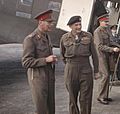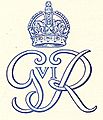George VI of the United Kingdom facts for kids
Quick facts for kids George VI |
|||||
|---|---|---|---|---|---|

Formal portrait, c. 1940–46
|
|||||
| Monarch of the United Kingdom and the British Dominions (more...) |
|||||
| Reign | 11 December 1936 – 6 February 1952 | ||||
| Coronation | 12 May 1937 | ||||
| Predecessor | Edward VIII | ||||
| Successor | Elizabeth II | ||||
| Prime Ministers | See list | ||||
| Emperor of India | |||||
| Reign | 11 December 1936 – 15 August 1947 | ||||
| Predecessor | Edward VIII | ||||
| Born | 14 December 1895 York Cottage, Sandringham House, Norfolk, United Kingdom |
||||
| Died | 6 February 1952 (aged 56) Sandringham House, Norfolk |
||||
| Burial | 15 February 1952 St. George's Chapel, Windsor Castle |
||||
| Spouse | Elizabeth Bowes-Lyon | ||||
| Issue | Elizabeth II Princess Margaret, Countess of Snowdon |
||||
|
|||||
| House | House of Windsor | ||||
| Father | George V | ||||
| Mother | Mary of Teck | ||||
George VI was born Albert Frederick Arthur George Windsor on 14 December 1895, at York Cottage, Sandringham House. He became the King of the United Kingdom on 11 December 1936. He ruled until his death in 1952.
George VI became king after his older brother, Edward VIII, decided to give up his throne in 1936. Edward wanted to marry an American woman named Wallis Simpson. George VI was married to Elizabeth Bowes-Lyon from 1923 until he died. His oldest daughter, Elizabeth II, became queen after him.
George VI had a speech problem, which meant he would sometimes stutter. This made it hard for him to give public speeches, which was an important part of being king. An Australian speech and language therapist named Lionel Logue helped him. Their story was made into a movie in 2010 called The King's Speech. In the film, Colin Firth played George VI and Geoffrey Rush played Logue.
He became a very popular king throughout the British Empire. People admired him during the Second World War (1939–1945). He stayed at Buckingham Palace even during the heaviest bombings of the Blitz. Buckingham Palace was bombed more than twice, but he remained there. This made him a symbol of strength and courage for the British people.
He opened the Festival of Britain in 1951. He also worked closely with his wartime Prime Minister, Winston Churchill. They celebrated the end of the war together on VE Day. George VI was a heavy smoker and sadly died from lung cancer at the age of fifty-six. He was given a large public funeral.
Contents
Prime Ministers During His Reign
During his time as king, George VI worked with several important Prime Ministers:
- Stanley Baldwin (1935–1937)
- Neville Chamberlain (1937–1940)
- Winston Churchill (1940–1945)
- Clement Attlee (1945–1951)
- Winston Churchill (second term, 1951–1952)
His Family Life
George VI was the son of King George V and Queen Mary. His older brother, Edward VIII, chose to step down from the throne to marry Wallis Simpson. In 1923, George VI married Elizabeth Bowes-Lyon, who later became known as Queen Elizabeth The Queen Mother. They had two daughters: Princess Elizabeth (who became Queen Elizabeth II) and Princess Margaret (1930–2002).
Death and Public Funeral
King George VI passed away in 1952. On the day of his funeral, large crowds gathered in London very early in the morning. Thousands of people watched the event on television. The funeral procession arrived at Westminster Hall shortly after 9:00 am. More than 300,000 people visited Westminster Hall to pay their respects to the king's body, which lay there for three days.
Images for kids
-
Four kings: Edward VII (far right); his son George, Prince of Wales, later George V (far left); and grandsons Edward, later Edward VIII (rear); and Albert, later George VI (foreground), c. 1908
-
The Duke and Duchess of York (centre, reading programmes) at Eagle Farm Racecourse, Brisbane, Queensland, 1927
-
On the cover of Time, January 1925
-
Crown coin with George in profile, 1937
-
Cover of the 7 May 1937 edition of Radio Times, drawn by Christopher R. W. Nevinson, marking the first coronation to be broadcast, and partially televised, live
-
Franklin and Eleanor Roosevelt with King George VI and Queen Elizabeth, on the USS Potomac, 9 June 1939
-
George VI (left) with Field Marshal Bernard Montgomery (right), near the front lines in the Netherlands, October 1944
-
King George VI and British prime minister Clement Attlee (left) at Buckingham Palace, July 1945
See also
 In Spanish: Jorge VI del Reino Unido para niños
In Spanish: Jorge VI del Reino Unido para niños












